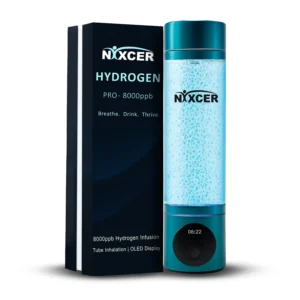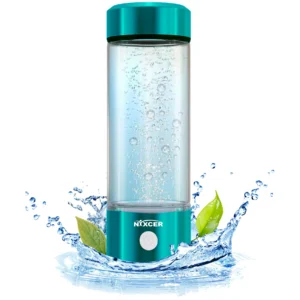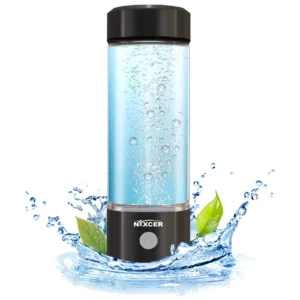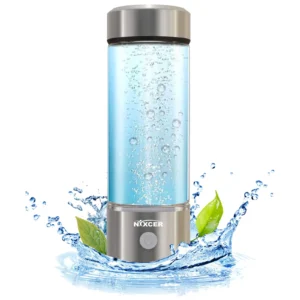
In recent years, hydrogen water has become immensely popular. People believe it can help with health. It may reduce oxidative stress and improve hydration. As consumers become more environmentally conscious, understanding the environmental impact of hydrogen water production and consumption is crucial.
At Nixcer, we are committed to offering sustainable hydrogen bottles that align with eco-friendly values. This blog post looks at the environmental effects of hydrogen water. It compares the production of hydrogen water to other methods. It also shows how Nixcer is leading in sustainable hydration.
Electrolysis produces hydrogen water. This process uses electricity to split water (H₂O) into hydrogen (H₂) and oxygen (O₂). The process then dissolves hydrogen into water, creating hydrogen-rich water.
The environmental impact of this process hinges on the energy source used for electrolysis. When using renewable energy sources like solar or wind, electrolysis produces green hydrogen. This process creates almost no greenhouse gas emissions. This aligns with the broader hydrogen economy, which aims to replace fossil fuels with clean energy alternatives.
If electricity comes from fossil fuels, it can produce a lot of carbon emissions. Fossil fuels include natural gas and coal. For instance, traditional hydrogen production methods like steam methane reforming (SMR) rely on natural gas and emit substantial CO₂.
Research shows that SMR can create 20 to 40 liters of water for every kilogram of hydrogen. This also includes emissions from extracting and processing natural gas.
Producers create green hydrogen through electrolysis. When using renewable energy, it needs 20-30 liters of water for each kg of hydrogen. This method also has a much lower carbon footprint.
Water demand is a critical consideration in hydrogen production. Electrolysis requires approximately 9 liters of water to produce 1 kg of hydrogen, with additional water needed for purification and cooling processes.
In large-scale hydrogen projects, this water usage can strain local water resources, particularly in arid regions. A mid-sized green hydrogen plant that makes 11,000 metric tons of hydrogen each year could use 26.4 million gallons of water. This water cannot recycle itself because it changes into hydrogen.
To mitigate this, innovative solutions like desalination powered by renewable energy can provide water without depleting freshwater reserves. Additionally, using treated wastewater or brackish water can further reduce the impact on local water supplies. Nixcer is mindful of these challenges and incorporates water-efficient technologies in our production processes to minimize environmental harm.
When compared to other bottled beverages, hydrogen water can be a more sustainable choice, especially when produced responsibly. Traditional bottled water and soft drinks often rely on single-use plastics, which contribute to global plastic pollution.
The making of these drinks uses a lot of energy. This includes bottling and transportation. These processes can harm the environment more than hydrogen water made with clean energy. By choosing hydrogen water in reusable bottles, consumers can reduce waste and support a more sustainable hydration option.
| Production Method | Water Usage (L/kg H₂) | CO₂ Emissions | Renewable Energy Dependency |
| Green Hydrogen (Electrolysis) | 20-30 | Near-zero (with renewables) | High |
| Blue Hydrogen (SMR + CCS) | 20-40 | Moderate (up to 20% of grey hydrogen) | Low |
| Grey Hydrogen (SMR) | 20-40 | High (significant GHG emissions) | None |
Note: Data is approximate and based on industry studies, such as those from the Rocky Mountain Institute (RMI).
At Nixcer, sustainability is at the core of our mission. We manufacture our hydrogen water bottles from high-quality, BPA-free stainless steel. This material is 100% recyclable and does not release harmful chemicals into the water.
We design our bottles for durability and reuse. This differs from disposable plastic bottles.. These bottles add 8 million metric tons of plastic to the oceans each year. This reduces waste and aligns with the principles of a circular economy.
Our bottles also feature advanced electrolysis technology that allows for on-the-go hydrogen infusion with minimal energy consumption. This innovative design ensures that consumers can enjoy hydrogen water without compromising environmental values. By prioritizing recyclable materials and efficient production processes, Nixcer sets a new standard for sustainable hydrogen bottles.
Nixcer is committed to minimizing the environmental impact of our production processes. We use renewable energy sources, like solar and wind, to power our manufacturing facilities. This helps reduce our carbon footprint.
We design our electrolysis systems to be energy-efficient, requiring less electricity to produce the same amount of hydrogen compared to traditional methods. This efficiency not only lowers emissions but also reduces the overall energy demand of our operations.
Beyond our products, Nixcer partners with environmental organizations to support water conservation and reforestation projects. For every bottle sold, we contribute to initiatives that protect local water resources and promote biodiversity. These efforts reflect our commitment to the hydrogen economy’s goal of advancing clean energy while safeguarding the environment.
One of the biggest benefits of using Nixcer’s hydrogen water bottles is less plastic waste. A single reusable bottle can replace up to 156 single-use plastic bottles each year. This helps save resources and reduces pollution in landfills and oceans. By choosing our sustainable hydrogen bottles, consumers can help the environment and enjoy the benefits of hydrogen water.
Hydrogen water is touted for its potential health benefits, including improved hydration, reduced oxidative stress, and enhanced athletic performance. A healthier population can reduce healthcare needs. This, in turn, lowers the environmental impact of medical waste and energy-heavy healthcare facilities. By choosing Nixcer’s eco-friendly hydrogen water bottles, people can support their health and help the planet.
The rise of the hydrogen economy offers a pathway to decarbonize industries, from transportation to power generation. By choosing hydrogen water produced with clean energy, consumers support the broader adoption of green hydrogen technologies. Nixcer dedicates itself to sustainable production. This supports global efforts to reduce fossil fuel use and promote renewable energy.
The environmental impact of hydrogen water production and consumption depends on factors like energy sources and water usage. Challenges exist in managing water demand for large hydrogen projects. However, solutions like renewable-powered desalination and efficient production methods can help reduce these issues.
Nixcer leads the way in this movement. They offer sustainable hydrogen bottles made from eco-friendly materials. Their production is energy-efficient, and they are committed to caring for the environment.
By choosing Nixcer, consumers can enjoy the benefits of hydrogen water while supporting a sustainable future. We invite you to check out our hydrogen water bottles. Join us in using hydration to help the environment. Visit Nixcer’s website to learn more about our products and our mission to lead in sustainable hydration.




Share Article:

The Ultimate Hydrogen Water Bottle for Health & Wellness
Copyright © 2025 Nixcer